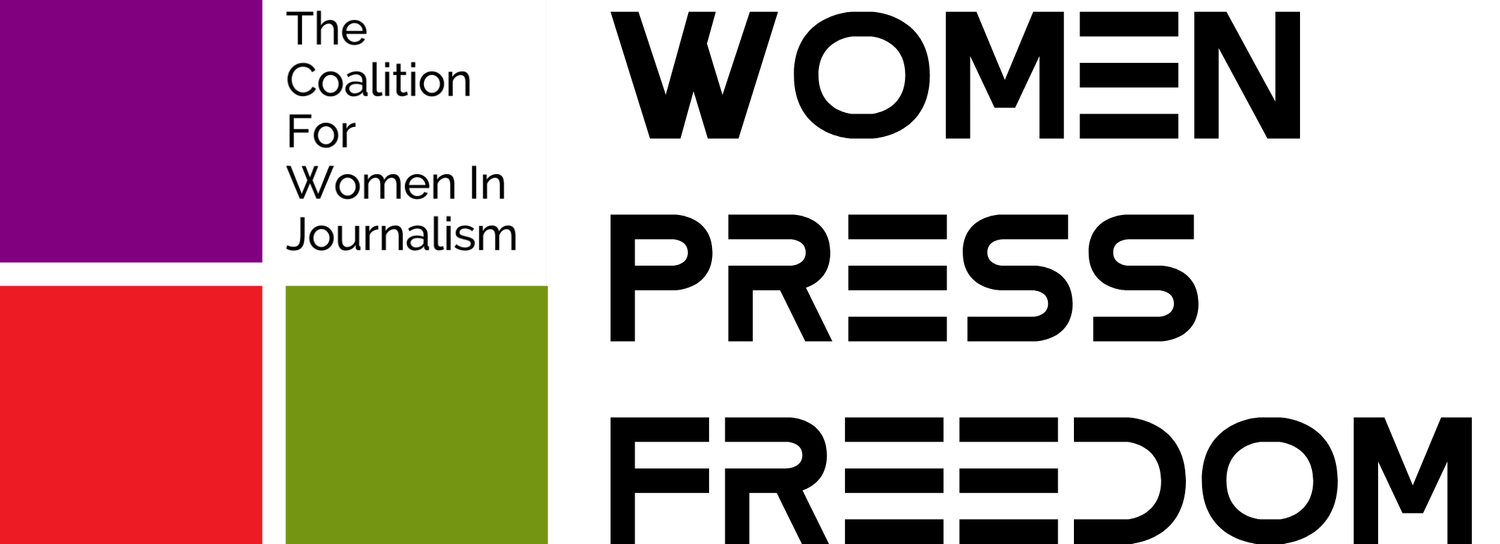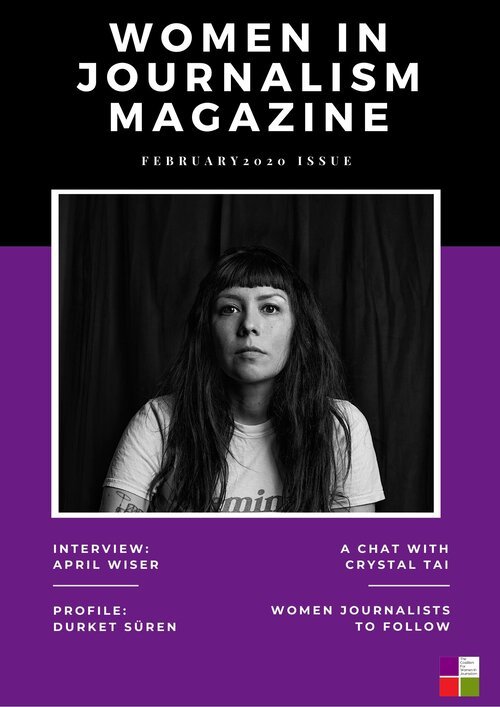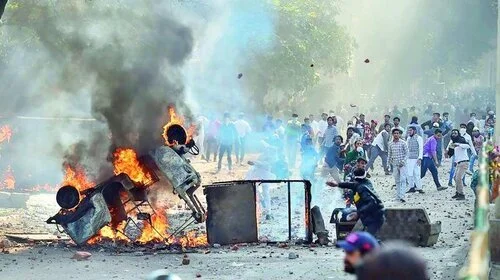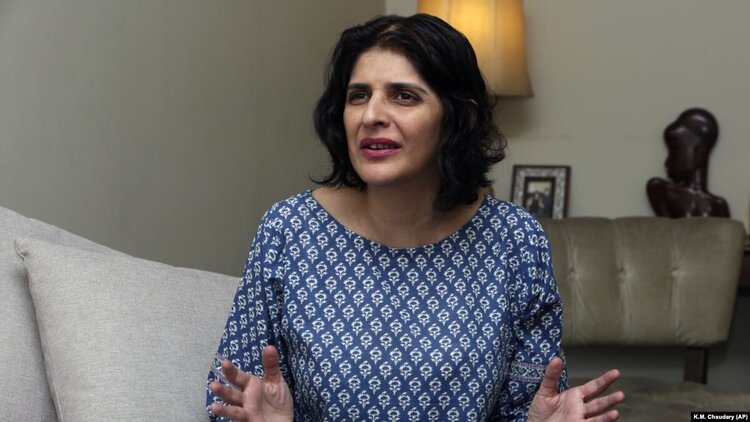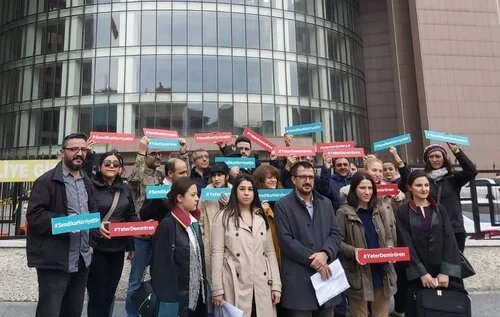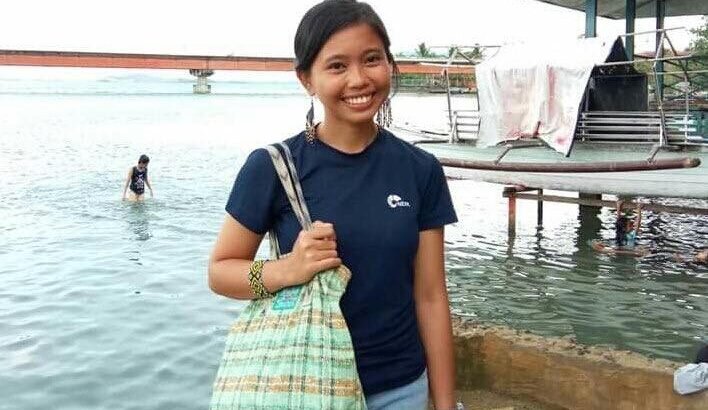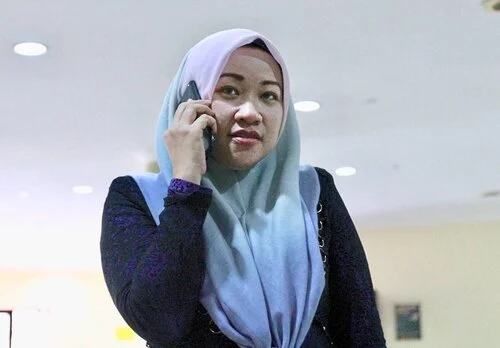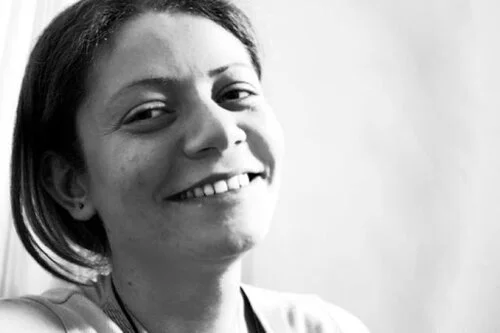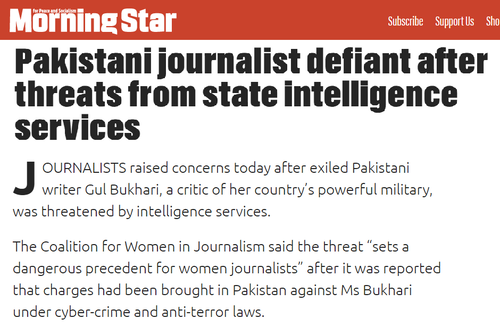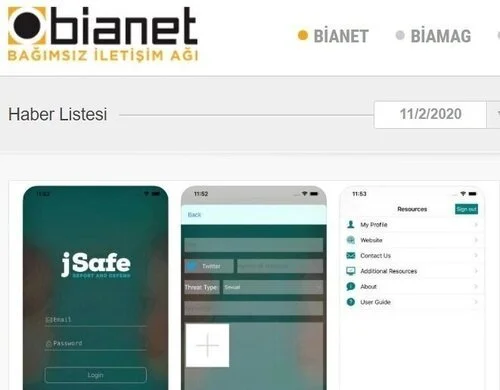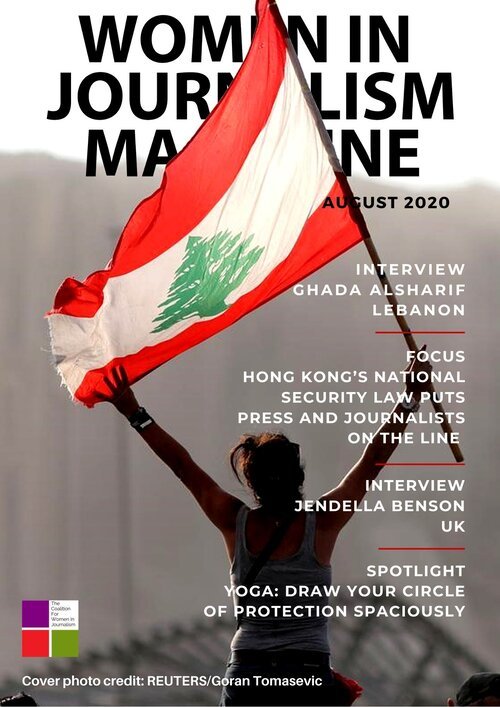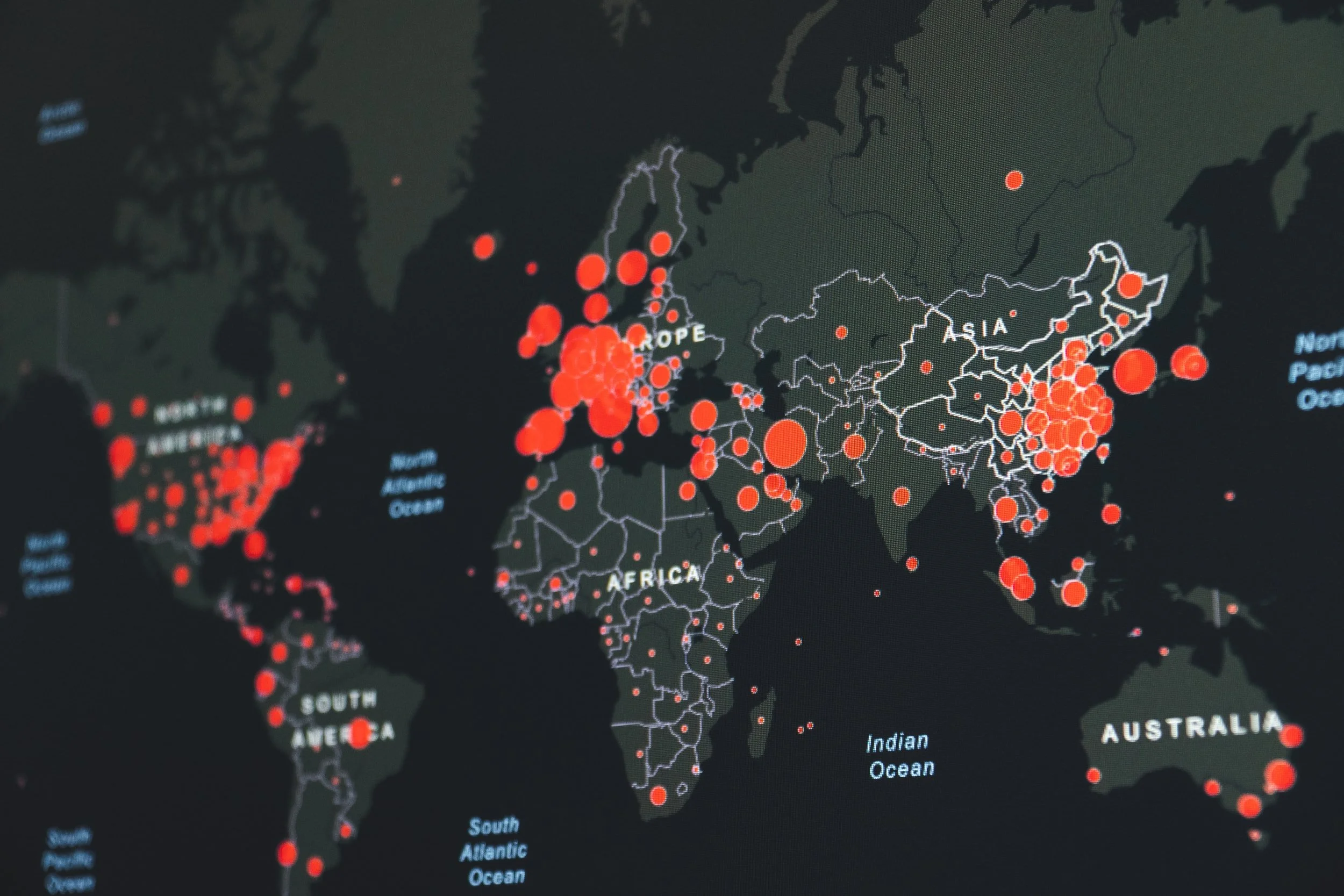February 2020 Issue
In this issue, we interview Foto Femme United’s April Wiser, have a chat with Chinese-Canadian journalist Crystal Tai and feature the profile of Turkish-Kurdish journalist Durket Süren. Go read.
Editor’s Note
Hello all,
We are all facing an unprecedented situation. The world has somewhat come to a standstill, and we hope to see things getting better again.
We have been closely watching developments around COVID-19 and will be soon launching a resources page on our website for both journalists and newsrooms. This will include a map of the world which will help you track down locations where women journalists are reporting on the story.
This particular magazine that you are viewing was created before the novel coronavirus took over our lives. For the last week and a half, we have been mostly spending our time building useful resources and helping journalists work in such a difficult time. You will be able to access all of this shortly. In the meantime, we decided to launch this issue as it was left.
We are excited to feature the Paris based CEO and founder of Foto Femme United April Wiser; profile of Turkish journalist Durket Süren whom we nominated for an international award, and highlights from a long chat with Chinese-Canadian journalist Crystal Tai.
Our recommendations for journalists to follow and top four fiction and non-fiction picks by badass women authors is a special treat.
Hope these bites are enjoyable.
We will be in touch with more soon
Stay well.
Happy Reading!
Index
Interview - April Wiser
an international women’s photography collective and community based in Paris, France. She is a publisher and an exhibited photographer herself who has explored themes around fine arts, women, fashion and much more through her extraordinary work.
Using their innovative and feministic platform, April and her team highlight the work of women, non-binary and transgender photographers and writers. We recently interviewed April about her journey, and inspiration that led her to establish FFU, the future of women in the photo industry. Read ahead.
CFWIJ: Photography is a powerful tool. How far have we come with representation of women photographers and photojournalists across the world? Do you think it is being used to its potential?
April: No. This is something I am really trying to express. It (photography) is the one language that transcends all of the others. We can’t really say that about any other verbal language where we can just look at something and collectively everyone has some sort of understanding. With the power there is also a lot of responsibility. In my opinion, the photo industry is not serving the public well because it is really male-dominated. It is only one perspective of a story.
When I was a student, we would often do these exercises where we would all go to the same event and look at the variety of different things people shoot, the way they shoot, the perspective, the intimacy and the expression that you can get from people. It is really male-dominated and we don’t have the whole side of the story. A lot more needs to be done to bring women and their work in the spotlight, and give us an equal chance to tell a story.
Foto Femme United is a very powerful platform for women in the photo industry. What led you to take that first step and establish a community that tries to intertwine feminism and representation of women using photography?
It was from my own personal experiences while dealing with sexism in the photo industry. I am a photographer and have been to school with a lot of women as well, so after having discussions with them and realizing that all of them have at least one similar story. It was not just an isolated incident and not just something in my head. We then started a collective towards the end of 2017 and it evolved over the years. It was really small with me and two other women at the time, and we decided to feature photographers.
In terms of social media, there was difficulty in doing that because of the shadowbanning and the removal of photography because there is nudity. Even if you follow and respect their community guidelines, they will still shadowban you and remove your photographs. It started getting really suffocating, so we had some discussions about it and realized that we could just build our own website. I started doing a lot of research as well to see how the situation was; and it was much worse. So we started developing different content and finding contributors. It was really important for us to have all kinds of perspectives; and today, there are 23 of us now.
How do you and your team brainstorm ideas?
Sometimes we look at different themes. They usually pitch their ideas to me and I am more like a timekeeper. I make sure that nobody is stepping on each other’s toes and writing about the same thing. I usually leave it pretty open and give them some direction. Sometimes, we have different photographers submitting press releases for their exhibitions or different people approaching us to be featured or written about, so we incorporate those kinds of things as well. Most of the topics just happen to be around women. It is not advised but it is just their choice most of the time. It is important that they are featuring photography by women, non-binary people or transgender photographers.
Foto Femme work is based around women. How do you make sure there is diversity of background, more inclusion of women of colour?
Most of the projects we feature are from Latin America right now. Sometimes we have French photographers but we do have some different photographers from Europe. This is something I have been discussing with my team. A lot of times we work on the different submissions we receive. But I have been speaking to my team to go out and dig in to find some photographers in different areas that we haven’t covered very much.
What is Foto Femme United’s process to discover photographers for the exhibition?
The recent exhibition was an open call for women. This was our first one, so it was not too bad. We received 139 submissions, so that is over 400 photographs. It was really diverse and submissions came from all over the world, which was really an honor.
For a lot of different competitions, you have to pay, so all the printing, and send submissions over. Sometimes, it is across the world, which can be very expensive. We understand that a lot of women working in this sector are not really being paid as much as men. So we wanted to make this really accessible to anyone, which is why there was no submission fee. We are actually covering the cost of printing and framing as well.
What efforts do you have to consider to sustain Foto Femme United?
We have a lot of different content that we are showing right now. The idea is to find other ways offline as well. We do a lot of things online but we are now starting pop up exhibitions. I started in Paris because it is practical for me. Since it was our first time, it was a test to see how it goes. Then we just have to look at how it went and see where things need to be modified. But the idea is to have these exhibitions worldwide in order to give more opportunity to women, so they can exhibit their work. I do have some other things which are in progress right now, but since we have not finished, we are not going to make any announcements about it just yet.
The ongoing exhibition by FFU is focused on censorship. Please tell us more about that.
I wanted it to be something really confrontational because people are scared around the topic and they think it is really annoying. But it is much deeper than that. So I really wanted to show people that it is more than annoying and the effects that it can have on people in general. It is a photography exhibition but it is also showing the kind of things that they are blocking on Instagram and other social media.
It is a moment to educate people and make them aware about how social media censors people. They pass content by companies or accounts, which are clearly about money or influence because these accounts are allowed to post something that does not even respect their own guidelines. We or other feminist accounts are unable to post content because it is maybe not an idealized version of a body or it is not a young person. I really find that dangerous and it is perpetuating this old thinking.
I wanted to choose something that I find really relevant and something that people can think of in a deeper way.
What kind of feedback has the exhibition received so far?
At the moment, we have not really received any backlash. I thought there would be a lot more because I was trying to compare the different comments that people may have. From time to time, we have received comments from different men and there is still a lack of understanding about why these different groups exist. A young man recently if they were any men working on the project, I had to explain to him that our approach is to push women, non-binary and transgender photographers and writers in order to achieve equality. There is still some work to be done so that everybody understands what that means.
With several collectives and communities like Foto Femme United, and others such as We Women and Women Photograph to name a few. How do you see the future of women in photography/photojournalism evolving?
It is definitely a good start. Women Photograph’s platform is becoming quite huge. They are doing so many different things both online and offline like workshops. The more we go forward, there will be even more similar groups and collectives. The best way to at least start is to take matters into your own hands. We should not wait around for things to work out on their own and use social media to express what we are thinking about the situation.
Do you think there is a shift in the narrative about women and non-binary individuals claiming their space in the global photography industry?
I have been really trying to find some numbers about it and the fact that I’m having a difficult time proves that there is still a lot of work to be done. I’m glad that at least it is being addressed. We have started seeing those words more often but quite honestly more work needs to be done.
How much has social media helped in creating wider possibilities for a greater number of women in photojournalism?
There are so many people who use Instagram. Personally, I use it more than Facebook. In terms of image and video, it is the platform to use. Despite their efforts to shadowban and remove people, it is still moving forward and photographers are being discovered that way. We have also discovered really amazing photographers that have submitted their work to us. It is really touching to be able to show their work in print magazines as well and help them move forward in their careers.
What advice do you have for women who want to pursue photography but are often, to this day, let down because of the space dominated by men?
I would say you need to be daring. You really can’t be somebody who waits around for things to come to you. You have to go and demand it yourself. You really need to be a self-starter, find your voice, find what it is that you really want to do and don’t be afraid to take risks.
“The Existence Of Women Frightens The System” — Durket Süren
Journalists have to pay a hefty price to do their job in Turkey. The country has had a history of persecuting journalists and suppressing freedom of the press. Since the beginning of 2020, we have been monitoring lawsuits against women journalists. Most of them are subjected to legal harassment and are facing terrorism charges.
Durket Süren is among the many women journalists who have been legally intimidated by Turkish authorities for their journalism. She has been accused of “willingly helping a terrorist organization" and "creating propaganda for a terrorist organization”. So far, three hearings of her trial have been held in Diyarbakır. Most recent hearing of her case took place on February 5, and the trial has been adjourned until May 18. Read our statement.
CFWIJ spoke with Durket to understand what it is like to work as a woman journalist in Turkey, how threatened and vulnerable she feels considering the state of press freedom in the country, and the persecution she has been subjected to in relation to her journalism.
Durket talked about the time after Özgür Gün TV was shut down. Even though it was a financially difficult time for her, she continued to pursue journalism.
“I left after the media outlets were closed by executive decree during emergency in August 2016. After a while, I winded up the newspaper distribution company, earlier established by me, due to financial difficulties. Following the declaration of the state of emergency, I continued working as a journalist, to see the truth, to announce and to convey it to the public, although the pressure on journalists increased even more,” she said,
In 2017, Durket began working as a reporter with Jin News Agency - an agency run by women focusing on Kurdish and women’s issues. Durket recalled the time when Turkish authorities began to intimidate her in March 2018.
“During the identification control in the field where I went to report, I was kept waiting for hours and was subsequently blocked,” she said.
Durket was detained while reporting in Diyabakir’s Lice district on the basis of search warrants against her from March 1 to 5, 2018. During detention, the authorities investigated Durket for her social media posts. She was released after being held for four days, but a travel ban was imposed on her. After the establishment of Jin News Agency in 2012, those associated with this news gathering organization have been facing persecution at the hands of Turkish government.
“I was taken into custody for my journalism. I was threatened and subjected to violence during, before and after my detention. My activities as a journalist were judged, which is why I became the police’s target. I spoke with the press at the Diyarbakır Human Rights Association on May 8, 2018, and filed a criminal complaint at the prosecutor's office, where I emphasized that journalism was not a crime,” Durket shared when speaking with CFWIJ.
Currently, Durket’s work is focused on women and their struggles. However, it is not easy for her to get stories published without interrogation.
“I remain under pressure by questions such as who I work with, where my shots will be published, and the reason for the topics I have chosen,” she said and further added that it is hard to work in the field as a woman journalist.
“In the male-dominated system, the most difficult thing to do is to work in the field as a female journalist, because men monopolise every field. The existence of women frightens the system. We are exposed to violence while following the news, pursuing the truth and trying to convey the real agenda to the society. We are exposed to professional bullying by male colleagues in the field caused by mental problems,” Durket lamented about the state of affairs for women journalists in Turkey when speaking with the CFWIJ.
Durket believes in resilience, even in the face of adversity. Despite threats and fears, she wants to continue pursuing journalism as a profession and challenge the status quo.
“I will continue to stand against censorship, oppression, as well as the sexist attitude of the government. I will continue to pursue facts and struggle to be able to publish them,” she said and added, “Unfortunately, Turkey has become a very dangerous country for journalism. We are exposed to detentions, arrests and threats; therefore, we are forced to remain silent. Journalists can be arrested for their social media posts. This needs to end and an environment should be created for journalists to write freely.”
Towards the end of our chat, Durket shared with us how she wants to fight against the oppression of press freedom in Turkey.
“To protect journalism from the oppressive system, as well as curb pressure and violence, I want to develop independent journalism. I would want to raise awareness against systemic and social pressures, as well as manipulation of journalism,” she shared with The CFWIJ. She also emphasized on changing the masculine language within the media.
Durket also spoke about her wish to create safe spaces for women journalists in Turkey. “I want to create areas and ensure an environment where more women journalists can work. Considering the responsibility and awareness surrounding journalism, collaborate with journalists, regardless of the opinion and identity against censorship, self-censorship, intimidation,” she said, as we wrapped up our conversation.
A Chat With Crystal Tai
Crystal Tai is a Chinese-Canadian journalist based in Hong Kong. She covers cultural criticism. Our Founding Director Kiran Nazish had a chat with Crystal, when the two met in Vancouver. Kiran asked Crystal about her work in Hong Kong and South Korea, covering the Hong Kong protests, how they unfolded and evolved. In the conversation about Crystal’s work in Korea’s misogyny problem and #MeToo movement, the two stumbled upon Korea’s K-pop and K-beauty industries, as well as facing discrimnation as an ethnic Chinese in the country and a lot more. Scroll through some of the highlights of Kiran's chat with Crystal. Read the longer version here.
Kiran: You were in Hong Kong when the protests took place. How long were you able to cover the protests?
Crystal: I joined the South China Morning Post (SCMP) as a reporter on the Asia desk near the end of 2018. I’ve been in Hong Kong the entire time since the protests began last year.
K: There were other protests earlier, a couple of years ago. Were the recent protests linked to those in 2014? Or were the recent ones different altogether?
C: Those were the umbrella protests. Those protestors were also asking for democracy, universal suffrage, and recognition of human rights in Hong Kong. But the current protests were propelled by an extradition bill that the Hong Kong government had proposed.Carrie Lam - the chief executive of Hong Kong - was in contact with the family of a woman murdered by her boyfriend - a Hong Konger - in Taiwan. She wanted to find a way to send the murderer back to Taiwan. Considering that Hong Kong and Taiwan have no extradition law between them, they were not able to send the man back to try him for the murder and this is how the bill came about.
K: Considering China’s long history with Taiwan and Hong Kong, as well as the concerns of the country not being pro-democracy. Was the cancellation of the extradition bill a big change? Was it a relief or a discount?
C: There was a sense of widespread relief when it was cancelled. But the problem is that the protests over the extradition bill snowballed into a larger movement and other demands rose up. As social unrest continued and police violence against protesters increased, the cancellation of the bill was not enough. People had been scarred by other events within this prolonged period and public dissatisfaction was at an all-time high.
K: So everyone wanted to join the protests for their own agenda, based on their own narratives?
C: Everyone wanted their own piece of pie, walking around with donation boxes around their neck. That was when it started fragmenting a bit and then the police violence escalated with (the use of) rubber bullets, tear gas and physical assault. The protesters divided into a few groups. There were the more hard core and radicals, as they were called. Then there were other groups that came every now and then during larger marches because maybe they felt safer with their families.
K: At what point did the protests in Hong Kong turn from being non-violent to violent? And did that affect how many people joined eventually?
C: It did have a tremendous effect because according to numbers, those protests brought about two million people (on the streets) in a city of seven million and that is a huge amount. This was one of their earlier protests, where the environment felt very organic and very real.
K: Do you think the coverage of the HK protests was wholesome with South China Morning Post and was there any sense of censorship within the local press during the protests?
C: This is harder for me to speak about because I was on the Asian desk and not the Hong Kong desk. The Asian desk offers more regional insights and coverage of the area, so I was not involved in the day to day business in Hong Kong. I did more big picture stories. But SCMP got a lot of criticism at the time for the way things were covered. Because I was not on that desk, so it’s not my place to speak about it. But it was criticized a lot.
K: Could you speak generally about the coverage in local press and on social media, as an observer? Any restraints or obstacles in coverage?
C: There was not so much censorship as much as there was a tremendous amount of fake news churning out all the time. These protests were super unique in the way that they ran by the philosophy “Be like water”, which is one of Bruce Lee’s saying that became one of the motives of the protests. To flare up and dissolve when you can. They were unorganized and leaderless. There was no one behind the movement running things, so people communicated anonymously via Telegram, so it was very easy to share (virtual fake news).
K: Since you covered the protests, how did you separate feeling emotional, engaged and connected to it, and then going back to write about it as an objective journalist?
C: I have always felt more like an outside observer. As a journalist, you connect with your subject and interviewees, so it is possible to sympathize and empathize. But maybe because I did not grow up in Hong Kong, it has made me very cautious. I do not want to speak for people whose experiences I have not lived and being obsessive, and paranoid, of doing that in my reporting maybe helped a bit.
K: Let's talk about your reporting in South Korea when you were based there. What was that like?
C: I arrived in South Korea in early 2014. I always wanted to report on a dynamic, up and coming, culturally ripe place in Asia, so Seoul seemed to be it. I decided to take the chance to leave my job in Hong Kong, which was with another magazine, go to Korea and just work out on my own as an independent journalist. It was my first time freelancing and there was so much to learn.
Korea itself was a very interesting experience, as a woman of color. I had what you would call a contradictory privilege because of my western upbringing, my ability to speak English. But I’m also ethnically Chinese; and in South Korea, Chinese people are sometimes discriminated against.
As a person I felt, I was wanted and also unwanted. As a journalist, it was interesting because I would show up at interviews and people would think that I was the translator or there to do the PR, because I was this unassuming Asian person - a woman who would just show up.
K: When you’re able to blend into the society you get more access, but that can also be a disqualifier in certain ways. As a journalist, sometimes it can be compromising. Did you do any stories in Korea where you needed to speak to people in powerful places and how were you treated with sources like that?
C: I did a lot of business retail coverage in Korea. It was easy for me actually because I reported for Women’s Wear Daily. Everyone in the retail environment knows about them, so if I had to interview CEOs or executives, there was really no issue - that’s because of the foreign association. If I had been reporting for a local newspaper, it would most likely be very different. Although I do think journalists in Korea are in a position of power as well. That’s what I have heard at least about local journalists.
K: How do you find resources as a journalist in Hong Kong or Korea? What is your process of reaching your sources?
C: I don’t think I’ve really been in a position where I need (to reach) that one person. I enjoy writing more big picture pieces and when it comes to analysis on an issue, I try to get to as many different voices as possible for each one.
K: What would your top tip be for fellow journalists?
C: I want to share this tip with any new, aspiring journalist that getting sources is really tough but it’s all about the approach. I try to share as much information as I can with my sources or potential sources ahead of time, so they get a sense of what the story is about and what kind of questions I’ll ask them. Let them know that their input is valued and that they would become a valuable part of the story.
K: Finally, what can you tell us about Ariana magazine?
C: It is a social justice publication based in Hong Kong and Macau. The goal is to feature unheard voices of regular people who are making a difference in the society or who are contributing in their ways, to highlight different causes in the region and to explore the nuances of our collective humanity. Right now, it’s a print publication. It comes out quarterly, even though in the future we will be publishing it three times in a year. There is also a website component where we publish regular news and stories on NGOs, and the good work that they do around the world. We also feature videos as well as explainers on activists and their lives.
Round Up Of Threats Women Journalists Faced
Press freedom is a luxury for many journalists around the world. In February, we documented 24 cases of threats and violence against women journalists around the world. Some of the most compelling of these cases are featured below:
Canada’s RCMP arrests American journalist for filming protests
American journalist Melissa Cox was arrested by the Royal Canadian Mounted Police (RCMP) in New Hazelton, while she was filming protests by the indigenous people on an unceded Gitxsan territory. She was subsequently released after seven hours of detention and interrogation.
Melissa has been working on a documentary focused on the resistance of Wet’suwet’en First Nation land defenders against Coastal GasLink’s pipeline project. Even though she carried her press credentials along, Melissa was handcuffed by the RCMP and tampered with her equipment. For additional prosecution, she has also been summoned to the court on April 24.
Radio journalist Teresa Aracely shot dead
Mexican radio journalist Teresa Aracely Alcocer, also known as Barbara Greco, was brutally murdered in Ciudad Juarez. The 37-year-old journalist was standing outside her home along with her father when a group of gunmen shot her.
The culprits fled the scene and remain at large. An investigation is underway by the Special Prosecutor’s Office for Women in Chihuahua, however the motive behind Teresa’s murder is yet to be determined.
Thhe city is notoriously known for femicides and violence against women. Teresa’s murder deterirated the already bleak situation for women in Cuidad Juarez.
Earlier in January, a women’s rights activist and artist, Isabel Cabanillas de la Torre was also killed for her activism. As per reports, Teresa had recently commented on a young girl’s murder in Mexico City.
Women journalists attacked during riots in India
During protests against the controversial Citizenship Amendment Act (CAA) in India, several Indian women journalists were reporting on the ground. After the situation between anti-CAA protestors and those favouring the law turned violent, riots erupted in the northeast side of Delhi. Journalists, too, were targeted amidst the violence which intensified on February 26.
Pro CAA protestors tried to attack Parvina Purkayastha, reporter of a mainstream news channel, with sticks and bricks while she was in the field doing her job. Another journalist, Runjhun Sharma stepped in to save her colleagues, while they were attacked filming a mosque set on fire.
One more journalist shared an instance of being attacked with stones and bricks by pro-CAA goons. A Muslim reporter Ismat Ara feared sharing her identity as a Muslim and tried to infiltrate the area without disclosing that she was a journalist; yet she was followed by multiple men who found her suspicious. The journalists shared how they were asked about their religious identity before being allowed to move on. The rioters were adamant to not allow filming of the situation in affected localities.
journalists , especially women journalists, in riot-affected areas are currently vulnerable to the violence. Those who are Muslims are working on the ground with an increased threat to their safety.
Gul Bukhari threatened with alleged “terrorism charges”
Numerous media outlets in Pakistan reported that journalist Gul Bukhari was summoned by the country’s federal investigation agency for her “defamatory remarks” against state institutions. This was clearly the state’s way to intimidate Gul for her blatant views on the policies of the state.
Gul, who is known for being openly critical of state and its policies, has been ordered to submit her response within 30 days of receiving the notice. In case she fails to do so, a court case under PECA [Prevention of Electronic Crimes Act] and the Anti-terrorism Act involving “terrorism charges” could be registered against her.
The notice was widely circulated across local media. Gul has denied receiving any such notice and FIA also maintained silence on the matter. A local English daily in Pakistan, The News, reported about the government of Pakistan’s letter to authorities in the UK. The letter has urged the UK to take action against Gul Bukhari for using “British soil for her nefarious activities” against the state.
Shaista Hakim faces gender discrimination
Pakistani female journalist Shaista Hakim, from the Swat valley was subjected to gender discrimination. Shaista, who is currently associated with a local news channel, is the first woman journalist from the once Taliban-controlled valley.
She was denied membership of the Swat Press Club and the Swat Electronic Media Association by her male counterparts, particularly the seniors. Shaista shared that the men were not comfortable with the idea of a woman being a part of such a club and association.
Journalism is a male-dominated field in Pakistan’s conservative Khyber Pakhtunkhwa province. It is not easy for women journalists to pursue a career let alone partake in clubs and associations mainly taken over by men. Shaista is, however, resolute to challenge norms and stand up to those who refuse who acknowledge her contribution to the local journalism industry.
Women journalists in Turkey continue to face trials
The way Turkish government treats its journalists is the reason why independent journalism is the need of the hour.
On February 13, Durket Süren appeared for the third hearing of the lawsuit against her. She has been accused of “willingly helping a terrorist organization" and "creating propaganda for a terrorist organization”. She is also accused of previously selling copies of Azadiya Welat and Özgür Gündem - both papers have been shut down by authorities in October 2016. The prosecution has requested the judiciary to sentence Durket to eight and a half to 20 years in prison. Her next hearing will take place on May 18. Read our statement.
Cumhuriyet’s reporter Zehra Özdilek is facing trial on charges of “targeting people who took part in the fight against terrorism”. Zehra is being persecuted for her news report about a corrupt public officer, wherein she has been accused of writing the name of a secret witness. She has denied all the accusations against her and insists that the news was written to inform the public. When addressing the court during her defense, Zehra has requested to be acquitted from the case. Read our statement.
Reyhan Çapan, the editor-in-chief of Özgür Gündem, and her colleagues have been sued with charges of “making propaganda for a terrorist organisation”, “praising crime” and “incitement to commit crime”. They have been subjected to injustice for a series of articles published in the paper before it was shut down by Turkish government in August 2016.
Meşale Tolu, a German-Turkish journalist, has been sued for "being a member of a terrorist organization" and "propagandizing for a terrorist organization". She was charged for attending a march in 2014, which was held to protest the killing of a student - Suphi Nejat Ağırnaslı - during the fight against ISIS near Kobane. The same year,
Meşale also participated in an anti-corruption demonstration, as well as attending the funeral of two women killed during a police raid on a house in Istanbul. The court has adjourned her trial until July 14.
Danish journalist Sultan Çoban has been sentenced to a year and three months for sharing a social media post with photos of Kurdish fighters in Syria. During the first hearing of her case, the court convicted her in the lawsuit accusing her of “making propaganda for a terrorist organisation”. Even though the announcement of the court’s verdict has been deferred, along with the removal of judicial control measures and travel ban, Sultan has not been acquitted.
Semiha Şahin and Pınar Gayıp have been accused of “membership of a terrorist organization”. Semiha also bears the brunt of additional charges against her for “making propaganda for a terrorist organization”. During the eighth hearing of their trial on February 27, the court adjourned the case until May 14, following the lack of digital examination reports in their file.
Employees of Hurriyet newspaper took the publication to court for their wrongful dismissal. The journalists, who were also members of Turkish Journalists’ Union (TGS), were notified about the termination through a letter. The 45 journalists were not given any compensation, legal rights or justice, and their email accounts and computers were also blocked.
Russian journalist Elena Milashina physically assaulted by angry mob, received death threats too
Russian investigative journalist Elena Milashina was attacked by an angry mob in Grozny, Chechnya. A group of around 15 people physically assaulted Elena and a human rights lawyer Marina Dubrovina in a hotel’s lobby.
They were in the city to follow the trail of a jailed blogger and the mob accused them of coming to “defend Wahhabis”. Both Elena and Marina were brutally beaten and kicked by women in the mob, while one of the men recorded the whole incident on camera.
Elena reported her ordeal with local police and has accused Chechen authorities for the attack. She stated that the attack was linked to her work, as she had been earlier threatened by Chechen government. The torture did not end there, as Elena has since been receiving death threats via the internet.
Gayle King - another victim of online harassment
American TV presenter Gayle King was subjected to online harassment after clips of her questioning Lisa Leslie about Kobe Bryant’s sexual assault charge began circulating. CBS, the TV network she works for, circulated the clip has condemned the harassment and threats directed at Gayle.
Susan Zirinsky, president of CBS News, extended her support to Gayle amid the threats and criticism. It was surprising to see celebrities like Snoop Dogg joining Bryant’s fans to abuse and threaten Gayle online. The rapper later deleted the questionable video and apologized to Gayle.
This was the second similar incident that took place in the span of a couple of weeks. Washington Post’s journalist Felicia Sonmez also received ire for sharing an article about Bryant’s sexual assault history. She was also suspended by her employers, but was reinstated after WaPo faced criticism by journalists and advocates of press freedom.
Filipino journalist Frenchiemae Cumpio arrested
Authorities in the Philippines arrested journalist Frenchiemae Cumpio, along with human rights activists during a raid across Tacloban on February 6. She has been accused of “illegal possession of firearms”.
Frenchiemae has been labelled as a high ranking officer of the Communist Party of the Philippines, which is considered a dangerous allegation in the country. She works as a correspondent of Altermidya Network and Eastern Vista. She has reported on human rights abuses in the Eastern Visayas region, particularly the victimization of the peasant community at the hands of Filipino military. Not long before her arrest, Frenchiemae informed her colleagues that she was being followed by unknown men. She was afraid they belonged to the military.
According to the military’s report, the alleged raids “identified Communist Terrorist Group safe houses” in the city. However, human rights organizations and those rallying for press freedom have all condemned the injustice that journalists and human rights activists are being subjected to.
Malaysian journalist Wan Noor Hayati faces trial for comments on social media
Malaysian government has charged an award-winning journalist Wan Noor Hayati with three counts of “causing public fear or alarm” related to the coronavirus outbreak in the region. She has been accused of allegedly commenting about the epidemic in relation to the arrival of 1,000 Chinese nationals on a cruise ship in Penang.
Wan has pleaded not guilty to the accusations. If convicted, she could face six years of imprisonment for each count. Wan is currently on bail and the next hearing of her case will take place on March 11.
After the arrest of journalist Razan Zaitouneh’s abductor, is there hope for her recovery?
Syrian journalist Razan Zaitouneh, her husband and two human rights activists were abducted on December 9, 2013. Islam Alloush, a former spokesperson for Jaish al-Islam, was suspected to have kidnapped Razan and those along with her.
The French police was informed about the whereabouts of Islam by human rights groups after three years of thorough research. He was finally detained from Marseille on January 31, following criminal complaints against him.
Despite the French authorities’ swift actions against Islam, there is no trace of Razan, her husband and colleagues till date. News of their abductor’s arrest reignites hope among human rights defenders and journalists, but the question of when all the captives will be released remains unanswered.
CFWIJ In The Press
Our statement condemning the threats Indian women journalists have been facing amidst communal riots in India was reproduced by Indian publication Firstpost.
We spoke with Gul Bukhari after she was allegedly slapped with “terrorism charges” by Pakistan’s Federal Invetsigation Agency. The report was featured in the UK based publication Morning Star.
Our friends at Nieman Lab highlighted the utility of the app and gave readers a rundown of how they can sign up for beta testing.
American Press Institute noted JSafe as an app that empowers female journalists.
Barazilian news outlets ANER and Portal IMPRENSA featured JSafe using an informational article about the app.
Turkish independent website Bianet covered JSafe.
An online platform in Turkey Ekmek ve Gül listed JSafe as their Application of the Day.
Journalist’s Toolbox and Poynter shared our call for JSafe’s beta testers.
Pakistani newspapers Pakistan Today and The Nation featured JSafe on their digital platforms.
Women Journalists To Follow
Masih Alinejad
Masih Alinejad is an Iranian journalist - currently based in Brooklyn, New York - known for her courage and strength to speak truth to power. Her unfiltered views about the authoritative Iranian regime makes her one of the most courageous journalists in the region. She is also known for her 2014 campaign - “My Stealthy Freedom” - to protest Iran’s mandatory public hijab law for women and girls. In 2017, she launched her campaign - White Wednesdays - to encourage women to either wear white shawls or remove their headscarves on Wednesdays as a symbol of protest. She has worked as an independent contractor with local and international media outlets including the Voice of America’s Persian-language service and the Iranian branch of Radio Free Europe/Radio Liberty.
Wudan Yan
Wudan is an independent journalist based in Seattle, Washington, USA. She tells stories by writing and photographing to make a living. Her words can be found on Buzzfeed, The New York Times, The New Yorker, Columbia Journalism Review, California Sunday Magazine, Huffington Post, and Longreads among several other outlets. Wudan writes about the environment, science, populations and stories of human interest. She also runs a business podcast - The Writer’s Co-op - for freelance writers with her co-host Jenni Gritters, where they discuss the woes of freelancers. When she is not writing, Wudan can be found sharing photos and stories of her German Shepherd June on Instagram.
Gulshan Khan
Gulshan is an independent photojournalist based in Johannesburg, South Africa. Her work is focused on human rights, identity, and social justice with topics ranging from climate change and environment to gender justice and healthcare. She has worked as a correspondent with AFP and was the first African woman hired by the agency in 2017. Gulshan’s work can be found in The New York Times, New Frame, The Guardian, The Washington Post, El Paris, among others. Her photographic prowess is visible through the visuals she captures.
Isabella Cota S
Isabella is a freelance investigative journalist based in Mexico City, Mexico. She was formerly associated with Reuters and Bloomberg. Her work has appeared in several international publications including The Guardian, PRI, and BBC among others. While working as a correspondent with Bloomberg, Isabella reported on business, finance, politics and social issues in Latin America. Her story on Al Jazeera about women getting hold of their rapist in Mexico shed light on the prevalence of sexual assault in the country.
News And Newsworthy
The 19th - a news outlet for women by women
A group of women in the US have established a news outlet for women who are under-represented and under-supported in the media. The online publication named The 19th is about reporting at the ‘intersection of gender, politics and policy’.
Lack of representation in newsrooms and broader media often results in the exclusion of important voices. It also impacts the selection of a story and does not do justice to its editing. So The 19th has been kickstarted to fill in the vacuum and brings the voices of more women to the fore.
South Korea finally has its first woman anchor
The live ‘News 9’ bulletin at South Korea’s prominent broadcaster KBS will now have the country’s first ever woman lead news anchor - Lee So-jeong. Lee has finally grabbed the opportunity and has made history by doing so.
She is now being hailed as an undeterred and prepared news anchor who has paved way for many women journalists in South Korea to take up the primetime news spot. Lee has taken over the studio, which was once dominated by men.
Politico journalist wins George Polk Award
Long Island University has honored Politico journalist Helena Bottemiller Evich with the George Polk Award in Journalism. She has been awarded for her series of stories including her environmental reporting focused on the Department of Agriculture and its ignorance towards the climate action plan.
Helena’s work also covered the Trump administration’s lack of interest towards climate change. Politico’s Editor Carrie Budoff Brown has deemed the award to be “more than just a recognition of Helena’s own world-class abilities.”
Helena is among the 15 winners who have received awards in 14 categories.
Lesley Visser to be the first woman to receive lifetime achievement Sports Emmy
Veteran sports journalist Lesley Visser will be honored with the lifetime achievement award at the 41st annual Sports Emmy. She has made history by being the first woman to receive the award.
According to the National Academy of Television Arts and Science, Lesley will be awarded on April 18 in Manhattan, New York. Considering her years-long experience and pioneership, Justin Gubar, the Executive Director of the Sports Emmy Awards said, “Lesley has spent her career serving as an unparalleled role model and mentor to countless up-and-coming journalists including myself.”
Opportunities
Metrics For Journalism In The Digital Age - Brazil
Brazilian communication professionals can apply for a partial scholarship for a short course that will teach them how to measure and monetize news audience. The course will take place on April 16 and 17 in São Paulo. Apply before March 22. Get all the deets here.
Learn social media strategies - Latin America
The Centre for Digital Journalism (CFPD) at the University of Guadalajara is offering an online course in Spanish for media professionals in Latin America. This course on social media strategies for institutions will help participants nail social media in their respective organizations. Register for this course before March 27. Details here.
Solutions Journalism To Migration Reporting - Europe
Journalists based in EU and those covering (or interested in covering) migration can apply for this solutions journalism training opportunity. The training will help you expand public narrative about immigration in the region and bring stories of immigrants to the fore, as well as the communities they have joined. Last day to apply is March 31. Details here.
Short film competition by We Are Water Foundation - Worldwide
The We Are Water Foundation is inviting entries for their international short-film competition. The competition's theme is climate crisis. Winners will be awarded in four different categories which include micro-documentary, micro-fiction, micro-animation and audience award. Deadline to submit entries is April 2. Details here.
Badass Women Authors
On their own: women journalists and the american experience in Vietnam
During the Vietnam war, a group of more than 500 women print and broadcast journalists were given the task of covering america’s activities in Vietnam. Many of these brave women lost their lives, some were wounded and others were taken as war prisoners. This gripping narrative written by veteran journalist Joyce Hoffmann gives its readers an insight into the unknown stories of these phenomenal journalists including the likes of Gloria Emerson, Beverly Deepe, Dicky Chapelle, Hate Webb, and others. This one is a must read.
The witch doesn't burn in this one
Amanda Lovelace continues to empower women with the second instalment of her famous women are some kind of magic series. Unlike the stereotypical fairy-tales we’ve grown up reading, this book teaches women the importance of self-love. It encourages them to be independent, uplift other women around them and be more accepting of themselves. Amanda surprises her readers using a witch as a symbol of empowerment. Every woman, especially young girls, should read this gift of modern literature.
Out on assignment: newspaper women and the making of modern public space by Alice Fahs
Alice Fahs brings to light the lives and writings of several women journalists in history. These ladies have contributed their services for major metropolitan newspapers in the beginning of the 20th century and broke stereotypes. They became a symbol of hope for women who sought new, independent and urban lives. But these women journalists hustled hard to get their dream job. Some of them took up challenging beats in the field, while others worked on women’s pages. If you’re a journalist looking for inspiration from the past, then this heavily researched book is for you.
Followers
Megan Angelo explores the current generation’s dependence on technology, their obsession with social media, as well as their craving for likes and followers in her gripping debut. The story revolves around three women and social media spanned between two time periods — 2015 and 2051. In 2015, roommates Orla and Floss want to get famous and gain more followers. The third woman Marlow’s story is set in 2051, when social media dominates everything. The book is a dark exploration of the perils of social media and its increasing influence in the future. You ought to have followers on your bookshelves if you enjoy reading speculative fiction.
